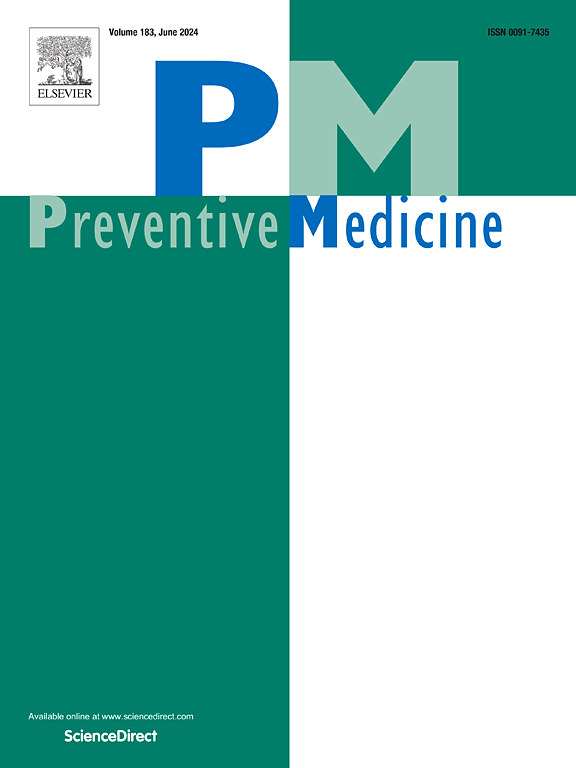Effects of the leisure-time physical activity environment on odds of glycemic control among a nationwide cohort of United States veterans with a new type-2 diabetes diagnosis
IF 3.2
2区 医学
Q1 MEDICINE, GENERAL & INTERNAL
引用次数: 0
Abstract
Objective. This study examined associations between access to leisure-time physical activity (LTPA) facilities and parks and repeated measures of glycated hemoglobin (A1C) over time, using follow-up tests among United States Veterans with newly diagnosed type-2 diabetes (T2D). Methods. Data were analyzed from 274,463 patients in the Veterans Administration Diabetes Risk cohort who were newly diagnosed with T2D between 2008 and 2018 and followed through 2023. Generalized estimating equations with a logit link function and binomial logistic regression were used to examine associations. Results. Patients were on average 60.5 years of age, predominantly male (95.0 %) and white (66.9 %), and had an average of 11.7 A1C tests during the study follow-up period. In high- and low-density urban communities, a one-unit higher LTPA facility density score was associated with 1 % and 3 % greater likelihood of in-range A1C tests during follow-up, respectively, but no association was observed among patients living in suburban/small town and rural communities. Across community types, closer park distance was not associated with subsequent greater odds of in-range A1C tests. Unexpectedly, in low-density urban areas, the likelihood of in-range A1C tests was 1 % lower at farther park distances. Conclusions. These results suggest that broader access to LTPA facilities, but not park proximity, may contribute in small ways to maintaining glycemic control after T2D diagnosis in urban communities. Tailored interventions may be needed to promote patients' effective use of LTPA facilities and parks.
在一项新诊断为2型糖尿病的美国退伍军人全国队列中,休闲时间体育活动环境对血糖控制几率的影响
研究目的本研究通过对新诊断为 2 型糖尿病(T2D)的美国退伍军人进行随访测试,研究了休闲时间体育活动(LTPA)设施和公园的使用与糖化血红蛋白(A1C)随时间变化的重复测量之间的关系:分析了退伍军人管理局糖尿病风险队列中 274,463 名患者的数据,这些患者在 2008 年至 2018 年期间新诊断为 T2D,并随访至 2023 年。研究使用了具有 logit 连接功能的广义估计方程和二项式逻辑回归来检验相关性:患者平均年龄为 60.5 岁,主要为男性(95.0%)和白人(66.9%),在研究随访期间平均进行了 11.7 次 A1C 测试。在高密度和低密度城市社区,LTPA 设施密度得分每增加一个单位,随访期间 A1C 测试结果在范围内的可能性就分别增加 1% 和 3%,但在郊区/小城镇和农村社区的患者中没有观察到相关性。在所有社区类型中,公园距离越近,A1C 检测结果不在范围内的几率越大。意想不到的是,在低密度的城市地区,公园距离越远,A1C检测在范围内的几率越低1%:这些结果表明,在城市社区确诊 T2D 后,更广泛地使用长跑锻炼设施(而非公园距离)可能对维持血糖控制有微小作用。可能需要采取有针对性的干预措施,以促进患者有效利用长跑锻炼设施和公园。
本文章由计算机程序翻译,如有差异,请以英文原文为准。
求助全文
约1分钟内获得全文
求助全文
来源期刊

Preventive medicine
医学-公共卫生、环境卫生与职业卫生
CiteScore
7.70
自引率
3.90%
发文量
0
审稿时长
42 days
期刊介绍:
Founded in 1972 by Ernst Wynder, Preventive Medicine is an international scholarly journal that provides prompt publication of original articles on the science and practice of disease prevention, health promotion, and public health policymaking. Preventive Medicine aims to reward innovation. It will favor insightful observational studies, thoughtful explorations of health data, unsuspected new angles for existing hypotheses, robust randomized controlled trials, and impartial systematic reviews. Preventive Medicine''s ultimate goal is to publish research that will have an impact on the work of practitioners of disease prevention and health promotion, as well as of related disciplines.
 求助内容:
求助内容: 应助结果提醒方式:
应助结果提醒方式:


